
No. 38690
At Matuo station, Hanawa line.
Japanese
|
1914 - 1975 A middle-sized Tender-Engine for mid-range light trains. |

No. 38690 At Matuo station, Hanawa line. |
|
In the 20th century, main line engines were gradually expected to have high power and high speed.
Therefore, the imported type C (Six driving wheel) engines were increased from type B (Four driving wheel) engines,
and they were the main engines in arterial Tokaido and Sanyo lines.
Improved class 8620's were appeared in 1914, as the heir of these imported type C main line engines.
672 (*) engines were made until 1930, this number was the largest manufactured number in passenger classes.
(* JGR - 672, Karafuto R.- 15, Taiwan R.- 43, Private R. - 2, Total - 732) The first 8620 was manufactured at Kisha Seizo Co. during April 1914, it has the manufactured number of 119. After its inception, No.8620 was active mainly Kyushu, Chugoku and Shikoku area. Finally, first 8620 was deregistered on the 11th of September 1958 at Matsuyama depot. Later she was moved to Saijo depot for safekeeping and due to its historical value. Afterward, 8620 was preserved at the Ome Railroad Park during 1962.
During 1922-1929, fifteen 8620s were ordered from Karafuto Railway (currently South-Sakhalin in Russian territory.) as a Karafuto Railway's Class 8620 No.8620-8634. When the Karafuto railway was integrated with the Japanese government railway during 1943, they were transferred to the JGR and renumbered with the ensuing JGR 8620's No. 88652 - 88666. During 1943-1944, fourteen 8620s were transferred from the Japanese mainland to the Karafuto Railway. Only one engine No.18665 (retired during Dec 1962 Sakura depot) was returned to the mainland during 1944. Karafuto Railway ordered 15 and transferred 14 with the exception of one returned engine, for a total of 18 8620s and were condemned by the Soviet Union when the war was over. Two 8620s were scrapped from accident damage during pre-WW2, and 19 were retired because of war-damage or their poor condition up to 1950. Therefore, with the exception of these, 638 8620s were active all over Japanese local lines during 1951. During March of 1957, one engine (No.8653) was sold to the Haboro Coal Mine Railway, and during March of 1959, No.58629 was also sold to this railway. They were active until 1970, and 58629 was preserved in the Haboro town. After WW2, JNR had planned the renewal of old age 8620s. This was done but after 1958, 8620s were gradually culled out. But the culling out was frustrated by a variety of factors, so nearly 30 engines were still active until 1973. They were ; 1 in the Morioka depot (No.48685)... Out of service. 10 in the Hirosaki depot (No.18677, 28622, 28667, 28683, 38689, 38690, 48640, 58635, 58666 and 78667) for the Gono and Kuroishi line, .... Service closed Mar 1973. 2 in the Fukui depot (No.28651 and 88623) for the North-Etsumi line. .... Service closed May 1973. 4 in the Wakamatsu depot (No.38629, 38634, 68660 and 88622) for the Muroki and Katsuki line. 1 in the Tosu depot (No.68623) ... Out of service. 3 in the Haiki depot (No.28629, 58648 and 58697) ... Out of service. (Matsuura line service closed Mar 1972) 2 in the Minami-Nobeoka depot (No.28627 and 78626) Nobeoka area shunting operations. (Hososhima branch line.) 2 in the Hitoyoshi depot (No.48647, and 58654) for the Yunomae line. 2 in the Kagoshima depot (No.48679, and 68649) Kagoshima area shunting operations. Finally, Hitoyoshi depot's two engines (No.48679 and 58654) were left on the Yunomae line. The last 8620 finished service on the 9th of March 1975. |
| Primary ran line in last 10 years |
Hanawa, Muroki, Yunomae, Togane, North-Etumi line, etc...
| Last line/depot and year |
Yunomae line / Hitoyoshi depot Mar.1975
| Restored engine (2017) |
2 (No.8630, 58654)
| Preserved engine (2017) |
18
| |
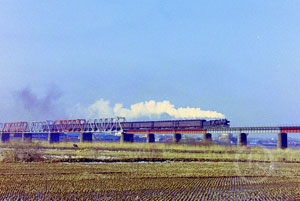
|
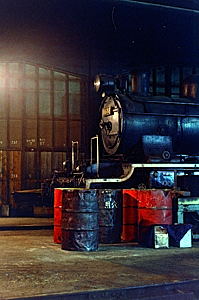
| ||||||||||||
|
No.8630 is seen here crossing the long bridge over the Noshiro River under the early spring sky. This No.8630 was restored in Umekoji museum. Noshiro in Gono line Mar 1972. |
No. 18688 Nagano depot Dec 1970.
| 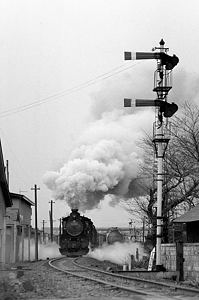
| 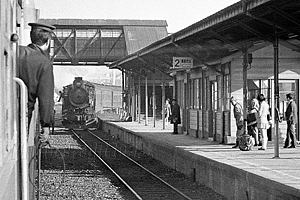
No.48640 is seen here with a semaphore signal... | a sight no longer enjoyed...but not forgotten. No.48640 has left Gosyogawara. Mar 1971.
The tablet for up-down exchange runs. | At Noshiro station, Gono line.
| 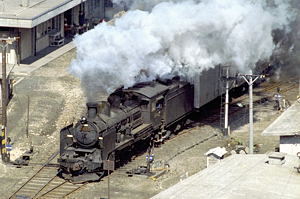
| 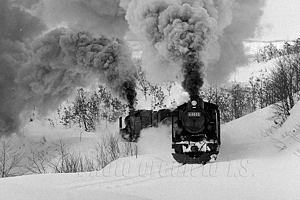
No.28688, Fukaura, Gono line.
|
68622 banking a freight train headed by 68622. | Hanawa line Feb 1970.
| 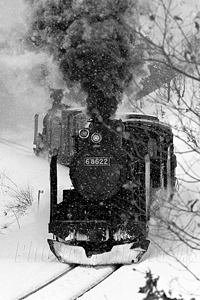
| 
68622 ascends a mountain summit | in the midst of a snowstorm with faithful 38690's banking. Ryugamori pass in Hanawa line, Mar 1971.
Seen here is No. 88638 with a tied off cab.... | could it be that it is being readied for retirement ? Umekoji, Mar 1970 |
| ||
|
The last 8620, 48647 left and right 58654 at the Hitoyoshi depot. During Mar 1974. (Photo credit to Nicholas Pertwee) |
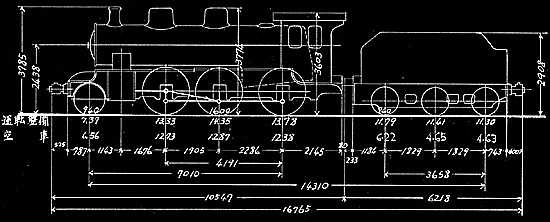
| Configuration | 2-6-0 | Dimensions Length (mm) | 16765 |
| Engine Weight (Operating tons) | 48.8 | Driver size (mm diameter) | 1600 |
| Boiler pressure (Kg/cm2) | 13.0 | Max Tractive effort (tons) | 10.4 |
| Driver Max Power (PS) | 630 | Max Speed (km/h) | 90 |
| Manufactured years | 1916-1926 1930 | Total production (National Railways) | 687 (672) |
| Number of moved out to other countries in WW2. | 28 | Gauge | 3ft 6in (1067mm) |
Introduction |
Go to Top |